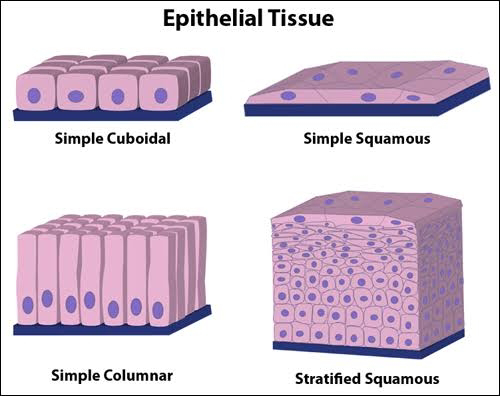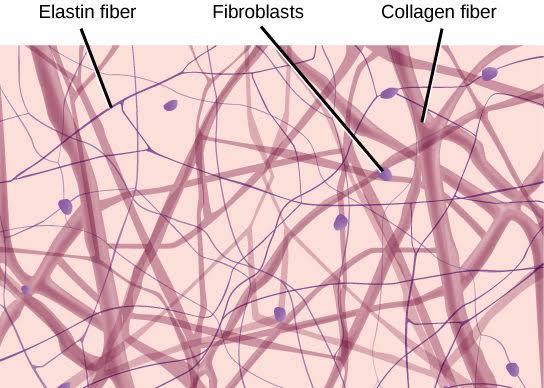Tissue
A tissue is a collection of cells that work together to perform certain tasks and typically share an embryonic origin. Four fundamental categories can be used to categorize animal tissues based on their form and function.
1. Epithelial Tissue
The cells that make up the membranes that line and cover the body's surfaces, as well as the glands that are formed from these membranes, make up an epithelial tissue or epithelium. There is some intercellular space between epithelial cells since they are densely packed and kept together by numerous cell connections. Because it does not have its own blood supply, epithelial tissue is avascular. Epithelial tissue plays many roles such as protection, filtration, secretion, absorption and excretion.
Cell shapes: There are 3 basic shapes -
- Squamous cells are arranged like floor tiles and are thin
- Cuboidal cells are as tall as they are wide and are shaped like cubes or hexagons
- Columnar cells are much taller than they are wide
Cell layering: They are classified in 3 layers -
- Simple epithelium is a single layer of cells
- Pseudostratified epithelium is mostly just one layer, but the shapes can be of different shapes and sizes.
- Stratified epithelium consists of two or more layers of cells.
Glandular epithelium -> This epithelium forms 2 different kinds of glands: Endocrine and Exocrine glands
- The hormones secreted directly into our bloodstream or to adjacent cells are produced by our endocrine glands.
- Instead of directly secreting their juices into the blood, our exocrine glands release their fluids into ducts or tubes that connect to the outside of our body or the inside of our tubes.
2. Connective Tissue
One of the body's most prevalent and plentiful tissues is connective tissue. The body and its organs are supported and shielded by it. Different kinds of connective tissues provide defense against pathogenic microbes, tie organs together, and store energy as fat.
There are two main types of connective tissue: extracellular matrix and cells. It features a large amount of extracellular matrix but few cells. The cells that make up connective tissue originate from mesenchymal cells. Ground materials and protein fibers make up the extracellular matrix. Three major types of fibers are present in the extracellular matrix - collagen fibers (composed of collagen), elastic fibers (composed of elastin and fibrillin) and reticular fibers (composed of type III collagen). Most connective tissues have a substantial blood supply because they are highly vascularized. Cartilage is an exception since it lacks blood vessels.
Classification of connective tissue :-
1. Embryonic connective tissue:
- Mesenchyme forms all the connective tissue and from this tissue almost all other connective tissues eventually arise. It is found under skin and along developing bones of the embryo.
- Mucous connective tissue is a jelly like substance that contains fine collagen fibers. It is found in the umbilical cord of fetus, which provides support.
2. Mature connective tissue: 5 types
- Loose connective tissue - Cells are loosely entangled with the fibers of the loose connective tissue. The types of loose connective tissues are Areolar (consists of fibers), Adipose (consists of adipocytes), and Reticular (consists of network of interlacing reticular fibers and cells) connective tissue.
- Dense connective tissue - Compared to loose connective tissue, dense connective tissue has significantly fewer cells but a higher number of fibers. There are 3 types, Dense regular (bundles of collagen fibers are regularly arranged), Dense irregular (contains collagen fibers that are irregularly arranged), and Elastic (consists of freely branching elastic fibers) connective tissue.
- Cartilage - Collagen and elastic fibers are woven into a dense network to form cartilage. Because it secretes a chemical that stops blood vessel growth, it lacks a blood supply. Most cartilage is covered in a dense, uneven layer of connective tissue called the perichondrium. There are two layers that make up the perichondrium: an inner cellular layer and an outside fibrous layer. There are 3 types of cartilage, Hyaline (provides support; ribs), Fibrocartilage (can withstand lots of pressure; vertebrae & knee joints), and Elastic (provides strength and stretchability; external ear, larynx & auditory tubes) cartilage.
- Bone tissue - Bone or osseous tissue is a living tissue. It is made up bone cells and an extracellular matrix known as an osteoid. Osteoblasts are the bone cells that generate the organic matrix. Bone tissue is categorized as either spongy or compact based on the arrangement of its cells and extracellular matrix. The inner layer of flat bones, such as the sternum, and the heads of long bones are the usual locations for spongy bone tissue. Strong yet porous, this tissue makes use of the extra space to produce and retain bone marrow. Conversely, compact bone tissue has no gaps and is extremely dense. It creates the outer layer of our bones and serves as a calcium storage for future bone cellular synthesis.
- Liquid (Blood) connective tissue - Blood is a liquid connective tissue made up of blood plasma and formed elements such as red blood cells (erythrocytes), white blood cells (leukocytes), and platelets (thrombocytes). Our blood's primary function is to transport nutrition, hormones, waste, and other substances while keeping all of our body's parts together. Unlike other connective tissues, it lacks fibers and instead contains a large amount of protein dissolved in plasma, which forms fiber-like structures when our blood clots.
3. Nervous Tissue
Nervous tissue is made up of neurons (nerve cells) and neuroglia. Most neurons are made up of three fundamental parts: a Cell Body and two types of cell processes called Dendrites and Axons. Neurons respond to stimuli, turn them into electric signals known as action potentials (nerve impulses), and conduct them. Neuroglia do not generate or conduct nerve impulses, but they provide vital support activities. Neuroglia account for more than half of the volume of neural tissue in our bodies.
4. Muscular Tissue
Muscular tissue is made up of cells called muscle fibers, which are specialized for contraction. Based on its location and specific structural and functional properties, it is categorized into three categories :
- Skeletal muscle tissue - It is attached to bones and long cylindrical striated fibers. It provides motion, posture, heat production and protection. This tissue is mostly attached to bones by tendons. It is considered as voluntary.
- Cardiac muscle tissue - It is striated, involuntary and forms the wall of the heart. Cardiac muscle fibers are branched and they attach end to end by transverse thickenings of the plasma membrane called intercalated discs (unique cardiac muscle tissue). It is found in heart wall. Its main function is to pump blood to all parts of the body.
- Smooth muscle tissue - It is small, involuntary, nonstriated, hence smooth. It is mostly present in the walls of hollow internal structures such as blood vessels, airways to the lungs, the stomach, intestines, gallbladder and urinary bladder. It controls motion like constriction, propulsion and contraction.








Comments
Post a Comment